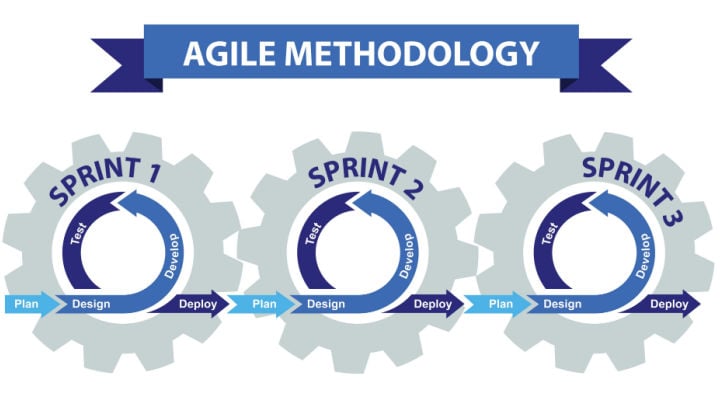SEO Tips for E-commerce: Improve Your Online Shop's Ranking in Google
SEO is an important tool for e-commerce businesses to bring in new customers. Here are the best tips for your online shop to rank higher in Google.

Agile methodology is a project management style that has become incredibly popular in the last few years. Software companies are quite fond of this methodology in particular. However, this approach shouldn’t (and isn’t) limited to software companies. It can be used for many kinds of projects. Let’s have a look at how and why Agile might be a good fit for your e-commerce business.
Table of contents:
Agile methodology is a project management system that advocates for self-organising, adaptive planning, flexible development, continuous changes, and early delivery.
The main idea is to have teams work with shorter (and multiple) deadlines. This allows for more feedback from end-users, while also providing them a working product sooner, even if it isn’t necessarily the final product.
Think of it like this: a user wants you to build them a house. Instead of giving the user a house in a year from now, you give them a gazebo after a month before continuing to build and improve the final product: a house. Users get a product with value (a roof over their head), while also being able to provide feedback in order to make the future house even better than originally planned.
These shorter deadlines and increased feedback loops can bring the following advantages:
You can think of it like you're breaking one big project into a lot of smaller projects (called “sprints”). After each sprint is “completed”, there is a time to reflect on what was (or wasn’t) accomplished, get feedback from the product owner/consumer, and then make some adjustments while planning the next sprint and product release.

Each project (i.e. sprint) has certain steps:
Planning, designing, developing, testing, and deployment
(Shutterstock/Maanas)
Don’t worry if this all seems new to you. Chances are that you’ve probably even heard some of the key terms that are popular in many Agile methodologies. They include words like “sprints” and “scrum master” (we’ll get more into that later).
Note: there are a few different frameworks for the Agile methodology. We will focus on Scrum, the most popular of these frameworks.
We won’t delve too deeply into the history of Agile, but many of the methods used in Agile can be traced back more than 50 years. However, in 2001, a group of 17 software developers came together to create the Manifesto for Agile Software Development.
These 17 developers put together a list of core values that were essential to this new methodology:
Although all the concepts here hold value, the concepts on the left (i.e. individuals and interactions) hold greater weight and value than the concepts on the right (i.e. processes and tools). As you can see, many of these values are focused on giving the process some flexibility as well as the expected final product.

Being agile means being "flexible".
(Shutterstock/Prostock-studio)
Along with the four core values/themes, there are also twelve main Agile principles:
We won’t get into the details of each principle, but as you can see, flexibility and feedback are two of the biggest core concepts in Agile. Through feedback and adaptability, it is believed that Agile can help companies product better products, faster.
Of course, many of these principles refer to “software”, this doesn’t always need to be the case. It can simply refer to a product, a website, or many other things.
There are a lot of key terms in AGILE that might be confusing. Let’s look at some of the most common ones:
The Minimum Viable Product (MVP) is an important concept in Agile. It is the simplest form of a working product that is created and released, but must also provide value to users, even in its basic form.
When starting a new project, “user stories” are defined as the key features or requirements that provide value to the end-user. All stories are given a “score” to define how difficult they are to complete.
We touched on this before. A sprint is a set period of time (usually between 2-4 weeks) whereby a certain number of tasks (i.e. user stories) need to be completed. Each sprint will have a certain number of user stories. Generally, this number will be somewhere between 5 and 15.
A backlog is a list of features and user stories that are planned to be worked on. When a new sprint begins, more stories are added to the tasks from this backlog.

A ticket system is a good way to keep track of ongoing tasks within a project
(Shutterstock/NicoElNino)
The “customer” in Agile, in this case, is defined as the recipient or user of the product. That means that “the customer” is not always a customer. Customers in Agile can be internal or external to the company. It can be one person, a department, or the end users.
Impediments are the hindrances that stop a team from being able to accomplish their goals.
Recommended reading:
How to Boost Your Sales Team's Efficiency and Avoid Burnout
This is one of those words you might have heard before. If you’re anything like me, you probably asked yourself “What is a scrum master?”
Think of a scrum master as the project leader. They are responsible for maintaining the processes and overall health and performance of the team. They organise team meetings and help when any hindrances or impediments stand in the team’s way.
The Product Owner has a very important role in Agile. They are responsible for defining user stories and prioritising the backlog. They are the contact point for the development team if they have any questions regarding the product or its features. In the end, the product owner represents the “customer”, whether that is internal or external of the company.
Daily stand-up meetings are essential to the Agile method. Also known as “dailies”, this is a short (around 10-20 minutes) daily meeting (usually held in the morning) so that team members can discuss their progress as well as impediments. They are basically daily status updates.

Short, daily stand-up meetings are a good way to keep the team on the same page.
(Shutterstock/VGstockstudio)
Retrospectives (or “Retros”) are also an important part of Agile. They are the post-sprint meeting to analyse how the sprint went. Members will examine what was successful and what needs to be improved. What is discussed in the retros should carry over into the next sprint.
Now that you know about the concepts, principles, and key terms behind Agile, let’s have a closer look at what the biggest advantages are when using Agile for your e-commerce projects.

Shutterstock/StratfordProductions
One of the biggest advantages that the Agile methodology brings any project is speed. By having short sprints, teams can create and release products to the market faster.
Thanks to the speed of the sprints, teams can take what they’ve learned from previous sprints and user feedback and adjust their user stories (and the vision of the final product) as the project progresses.
Whereas the classic “waterfall” methodology has teams follow a “set-in-stone” plan for months (or years) on end, Agile allows teams to stay up to date to the market’s demands.
Teams communicate more often and easily. With multiple feedback rounds, teams can make adjustments and identify more opportunities in the market.
By staying constantly in touch with each other (as well as the consumer in many cases), teams are forced to be more transparent and flexible. Agile encourages optimisation and adjustments, so a constant feedback loop means you’re much more likely to “get it right”.
As you know by now, Agile encourages testing at the end of each sprint. With a higher level of tests and quality control combined with more user feedback, you’re more likely to end up with a high-quality outcome and you’ll have the proof to back you up.
All the advantages mentioned above coupled with all the feedback you collect, will of course lead to better products. That, in turn, will lead to happy customers, especially if you include them throughout some of your processes.
Recommended reading:
Why are Customer Reviews so Important for Your Online Shop?
Agile methodology can be helpful to your e-commerce shop in many different ways. Here are some examples of what kind of e-commerce projects could benefit from Agile methodology.
If you are new to the game and just getting your online shop started, you can use Agile to get your shop working and online faster. The idea here is this: since your website will have mistakes whenever it’s released anyway, why not get those mistakes done earlier?
With a project like this, you’ll want to focus on user feedback. This won’t be easy, but with the right strategy, you can surely get this done. Whether it is an email to your customer or using focus groups, you’ll want to get that feedback and send it to your team so they can make the proper adjustments before their next sprint (and the next release).
Recommended reading:
How to Start an Online Shop: A Beginner's Guide
We all know competition can be tough. One way that you can stand out from the competition is by focussing on pricing. With Agile, you can brainstorm, test, and adjust your strategies more.
For example, you can make relatively quick adjustments to general pricing, promote sales, and change delivery options rather quickly. Alternatively, you can come up with ways to reduce costs and have that carry over to the consumer. The point is, with quick sprints, you can test, optimise, and adjust a lot of ideas in a short span of time.
Implementing Agile into your company structure is no easy task. People tend to dislike change, especially if they’ve been in the company for a long time.
However, if you’re just starting a new company, it will be a lot easier to get the right people on board and set your systems in place now.
On the other hand, if you are part of a company that already exists and you want to help transition your team to Agile, you may want to hire an Agile coach.
Agile coaches can be brought on to the team to teach you and your team the methods and ideologies in greater detail. They can also recommend some tools that they prefer. Alternatively, they can recommend tools and strategies based on your company’s specific needs.
If you want a taste of Agile, but aren’t quite convinced that this is the best strategy for your team, consider taking an Agile project management course. Better yet, start with a crash course. There are a lot of resources out there, including videos and blog articles. However, I’d recommend taking a dedicated class. Udemy, for example, has a variety of courses to introduce the topic to you in just a few hours.
Agile methodology can be a great way of improving the internal processes at your company. It can boost effective communication within your company while also improving the speed and flexibility of your team. All in all, this will lead to better products and happier customers.
16/09/20SEO is an important tool for e-commerce businesses to bring in new customers. Here are the best tips for your online shop to rank higher in Google.
Valentine's Day has grown in popularity across Europe. We're sharing some romantic statistics (redundant, right?) and look at 9 marketing tips for V-day.